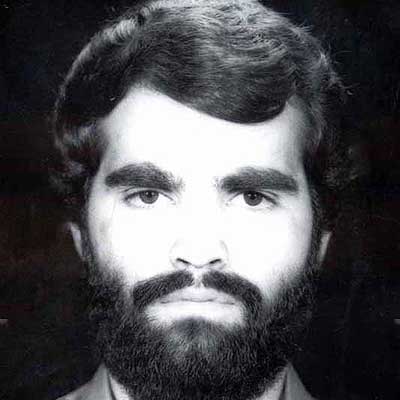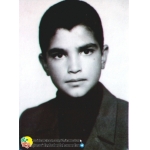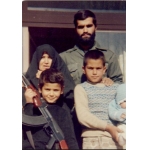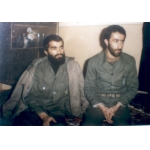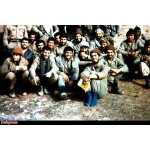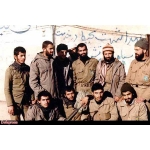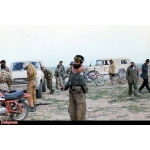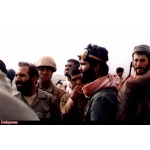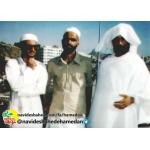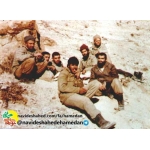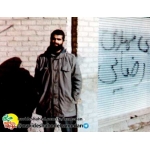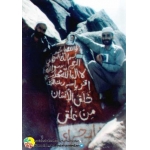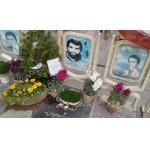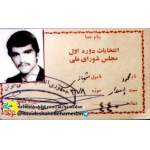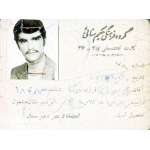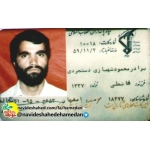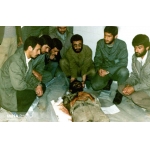Shahbazi Dastjerdi, Mahmoud
: Masoumeh Sajadian
268 بازدید
Mahmoud Shahbazi Dastjerdi (1958–1982) served as the commander of the Islamic Revolutionary Guard Corps (IRGC) in Hamadan Province and as deputy commander of the 27th Muhammad Rasulullah (pbuh) Brigade during the Iran-Iraq War. He was martyred in the battle to liberate Khorramshahr.[1]
Born in 1958 in Esfahan to a farming family,[2] Mahmoud Shahbazi completed his primary education at Hafez School and graduated with a diploma in mathematics from Ahmadiyeh Hakim Sanaie High School in 1977, a school affiliated with the Islamic seminary of Esfahan.[3] That same year, he participated in the national university entrance exam and was admitted to the University of Science and Technology in Tehran to study industrial engineering.[4] During this time, he also taught mathematics at elementary schools in Tehran.[5] While studying at university, he became involved in political activities and, through Mohammad Boroujerdi, joined the "Towhidi Saf Group.[6]" On February 1, 1979, he was selected as a member of the security unit of the Committee for Welcoming Imam Khomeini (ra), responsible for protecting him during this critical period.[7]
After the victory of the Islamic Revolution, Shahbazi joined the IRGC. While continuing his university studies, he worked in the coordination office of the IRGC’s central headquarters.[8] He also volunteered with the Jahad-e Sazandegi Organization, leaving Tehran for Damghan in Semnan Province.[9] Shahbazi was one of the Muslim Student Followers of the Imam’s Line who participated in the seizure of the former U.S. Embassy (later known as the Den of Espionage) on November 4, 1979. He remained at the embassy until late April 1980, after which he was tasked with transferring some of the embassy staff to Darreh Morad Beyk village in Hamadan Province.[10]
With the outbreak of the Iran-Iraq War, Shahbazi, along with his friend Mohsen Vezvaie, headed to Sarpol-e Zahab, where he was responsible for intelligence and leadership operations until late February 1981. About a month later, he was appointed commander of the IRGC in Hamadan Province.[11] There, he implemented significant organizational changes, including forming an evaluation commission and conducting qualification assessments of IRGC personnel.[12]
In September 1981, during Operation Bahonar and Rajai (also known as the Third Battle of Bazi Deraz), Shahbazi and his forces launched an attack against Saddam’s army, but the command was later handed over to Hossain Hamadani.[13] The operation ultimately failed due to intelligence leaks and a lack of support.[14]
In October 1981, Shahbazi was sent by the IRGC on a pilgrimage to Mecca. During the pilgrimage, alongside Ahmad Motevaselian and Mohammad Ebrahim Hemmat, he promoted the values and messages of the Islamic Revolution and Imam Khomeini (RA).[15]
Operation Matala al-Fajr was launched in December 1981 on the Gilan-e Gharb front. When the forces found themselves surrounded, Shahbazi broke the siege by launching a diversionary attack in the Tang-e Korak region.[16] He organized 135 volunteer forces[17] into three operational groups and one support group of 30 and 45 soldiers, respectively. Shahbazi and his radio operators stayed inside a cave in Tang-e Korak, directing the operation. The Iranian forces attacked the second line of a well-equipped Iraqi commando team and, without receiving any backup, managed to repel four heavy enemy counterattacks, rescuing several thousand besieged combatants.[18]
In January 1982, Shahbazi and 24 elite members of the Hamadan IRGC traveled to Khuzestan to establish the 27th Muhammad Rasulullah (pbuh) Brigade.[19] The brigade was commanded by Ahmad Motevaselian, with Mahmoud Shahbazi serving as his deputy.[20]
During Operation Fath al-Mobin, Shahbazi commanded the "Tappeh Cheshmeh" axis, covering Heights 220, 242, and 249.[21] His troops successfully repelled enemy counterattacks in the Dasht-e Abbas and secured the liberated areas.[22] Following this operation, he resigned from his role as deputy commander.[23] In April 1982, he assumed responsibility for the reconnaissance team of the Muhammad Rasulullah (pbuh) Brigade’s intelligence and operations unit. The team was tasked with gathering intelligence from a wide area, extending from the western bank of the Karun River to the Ahvaz-Khorramshahr Road.[24]
During Operation Beit al-Muqaddas, Shahbazi commanded the Salman area, where five battalions were active during the initial phase of the operation.[25]
On May 23, 1982, during the operation, Mahmoud Shahbazi heard the cries of an injured Basiji soldier on the Khayyen frontlines. He left his trench to help the soldier but was struck by a Katyusha rocket fragment and martyred.[26]
On May 24, 1990, the second-degree Fath Medal was posthumously awarded to the family of this martyred commander of the Sacred Defense by Ayatollah Seyyed Ali Khamenei, Commander-in-Chief of the Iranian Armed Forces.[27]
[1] Behzad, Hossein, Babaei, Gol Ali, Hampay Seqeh (Along with the Lightning), Tehran: Artistic Center of the Islamic Propaganda Organization, 2000, pp. 805 and 806
[2] Ibid.
[3] Babaei, Gol Ali, Hemaseh Bi Payan (Endless Epic), (Book 6 of the Twenty-Seven in 27 series), Tehran: Saeeqeh Publishing, Volume 2, 2013, pp. 16 and 140.
[4] Ibid; p. 25.
[5] Babaei, Gol Ali, Hemaseh Bi Payan (Endless Epic), p. 26.
[6] Behzad, Hossein, Babaei, Gol Ali, Hampay Seqeh (Along with the Lightning), p. 806, Babaei, Gol Ali, Hemaseh Bi Payan (Endless Epic), p. 30.
[7] Babaei, Gol Ali, Hemaseh Bi Payan (Endless Epic), p. 142.
[8] Ibid; pp. 36 and 37.
[9] Ibid; p. 143.
[10] Ibid; p. 39.
[11] Ibid; pp. 39, 40 and 42.
[12] Behzad, Hossein, Mahtab Khyan: Revolution, Kurdistan, and Sacred Defense as narrated by Basij Commander Hossein Hamedani, Tehran: Organization for the Preservation of Works and Publication of Values of Sacred Defense and Basij, 2010, p. 143.
[13] Babaei, Gol Ali, Hemaseh Bi Payan (Endless Epic), pp. 51 and 52.
[14] Behzad, Hossein, Mahtab Khyan, p. 205.
[15] Behzad, Hossein, Babaei, Gol Ali, Hampay Seqeh (Along with the Lightning), p. 74.
[16] Behzad, Hossein, Mahtab Khyan, pp. 250-256.
[17] Ibid; p. 262.
[18] Ibid; pp. 267 and 285.
[19] Ibid; p. 341.
[20] Behzad, Hossein, Babaei, Gol Ali, Hampay Seqeh (Along with the Lightning), pp. 146, 149 and 806.
[21] Ibid; p. 239.
[22] Behzad, Hossein, Mahtab Khyan, pp. 540-564.
[23] Ibid; p. 662.
[24] Behzad, Hossein, Mahtab Khyan, p. 401.
[25] Ibid; p. 429.
[26] Ibid; pp. 698 and 806.
[27] Babaei, Gol Ali, Hemaseh Bi Payan (Endless Epic), pp. 166 and 167.


